
by Richard C. Hoagland
with David Wilcock
December 9, 2007
from
EnterpriseMission Website
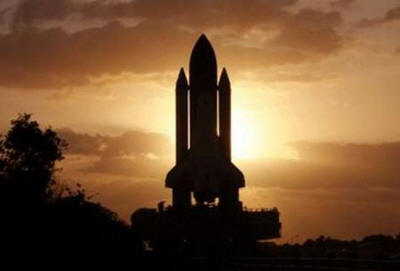
Today, a second launch attempt will be made to
get Space Shuttle “Atlantis” off the pad successfully in this December
window. Regardless of how this turns out, it’s now obvious that the NASA
Shuttle Program will continue grappling with the hydrogen tank "Engine
Cutoff Sensor (ECO) problem."
This has now been going on for over two and a half years after the NASA
engineers had thought they’d fixed it! The now-admitted "failure and
frustration" over this recurring shuttle problem among NASA’s senior
management is palpable.
This perplexing problem initially appeared just a few months prior to the
STS-114 launch of Space Shuttle “Discovery,” back in 2005, and its important
“return to flight” mission for the previously grounded shuttle program.
STS-114 was also the first flight of the shuttle following the tragic
Columbia Disaster of STS-107, in February, 2003.
Like the current sensor problems we are experiencing with “Atlantis,” this
initial “anomaly” for “Discovery’ was signaled by erroneous electrical
readings... coming from a set of four “engine cutoff sensors,” located at
the bottom of (and inside) the enormous orange fuel tank of the shuttle
(below).
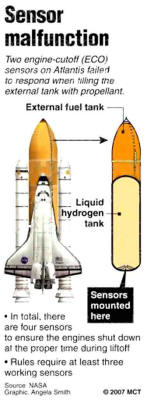
These maddeningly erratic, “on-again,
off-again,” apparently completely random failures in this critical shuttle
system soon became the focus of an enormous, expensive, NASA-wide
engineering effort - waged over the next two years.
NASA needed to determine (and then permanently fix) the cause of
these unpredictable failures in a “mission critical” shuttle engineering
system. The “ECO fuel sensors” are essential to launching a space shuttle
safely. Otherwise, the spacecraft’s on-board computer cannot warn of an
impending “low fuel situation” – caused by a depleted hydrogen level in the
massive shuttle tank.
The sensors, when they’re working properly, automatically trigger Main
Engine Cutoff before the engines would run dry, and potentially explode
as a result of losing all their fuel (below)!
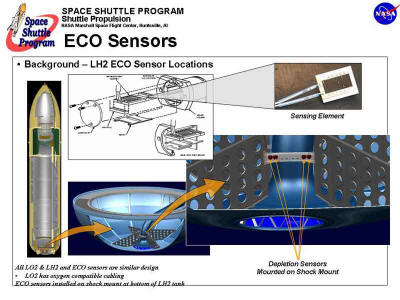
NASA is suffering from increasingly limited
resources in the face of other program challenges - such as "Constellation,"
which hopes to build an entirely new spacecraft, and “return to the Moon.”
Nonetheless, NASA admits it has spent literally MILLIONS of dollars in the
last two and a half years - expending thousands of engineering man-hours -
on what SHOULD have been a relatively simple engineering solution, for a
simple engineering problem.
The fact that NASA has spent all this time and money... and STILL has "a
recurring hydrogen level sensor problem"...is strong indication now that
"something radically new" is called for – in terms of both finding the
problem’s “root cause”… and then providing an acceptable engineering
solution.
It's past time, in my opinion, for NASA to embrace some serious "out of the
box" thinking on this mysterious "ECO sensor problem". NASA has already
expended an enormous effort on this issue.
And now as of yesterday, Shuttle
Program manager Wayne Hale announced,
"a new, Agency-wide, research and
engineering effort to finally resolve this continuing sensor problem..."
The alternative can only be more months
(possibly even YEARS...) of identical, equally frustrating and expensive
failures... to CORRECTLY analyze the underlying situation - let alone
implement a safe and workable solution.
Based on highly unusual “HD” experimental data collected in Florida over the
past three years by The Enterprise Mission, I am now strongly
recommending the instigation at NASA of a fundamental NEW research approach:
A formal NASA scientific investigation into
a possible "NEW PHYSICS" underlying this entire, scientifically
baffling, "shuttle sensor issue."
This recommendation is based, in part, on the
remarkable theoretical and experimental physics work clandestinely carried
out by scientists and engineers in the former Soviet Union over the past
half century - work that, until the collapse of the Soviet system in 1991,
was largely unknown outside Russia.
Even now, the number of engineers and physicists familiar with the
startling, highly controversial results of this all-but-classified Soviet
program is very limited.
Since Russia is participating in the
International Space Station Program
(below), one might hope that these highly relevant Soviet research results
could finally be shared... and applied by NASA to its current,
"increasingly serious" shuttle situation.
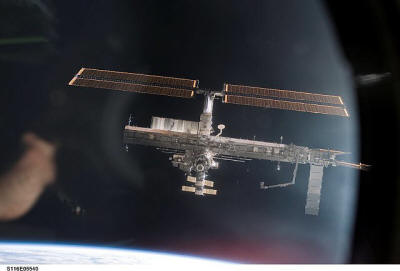
Briefly, what the Soviet Union discovered in
these radical experiments was that there exists in Nature - in addition to
the four known forces, a REAL fifth force - the so-called "torsion
field."
The theoretical foundation of this new science was laid out by Einstein
and Cartan over eighty years ago. In the original theory, these
fields were 'static,' meaning they could not move from point A to point B -
only appearing as the basic 'spin forces' within the atom.
Other Relativity theoreticians later proposed the possible existence of
dynamic torsion fields - meaning that these 'spin forces' can propagate
through space, creating "action at a distance" effects.
Soviet laboratory experiments in the 1950s, conducted by the
pioneering scientist Dr.
Nikolai Kozyrev, found irrefutable
proof of these 'dynamic torsion fields' in action.
Kozyrev, and others after him, found that the "torsion field" can indeed
affect electrical phenomena under certain circumstances. Electrical
resistors can experience substantial changes in how conductive they are,
especially when made of denser metals such as tungsten. Quartz
crystal oscillators can have notable changes in their vibrational frequency.
Photocells demonstrate measurable discrepancies in how much 'work' they can
perform.
Electrical anomalies are a classic sign of torsion-field
interference, as can be routinely seen in the well over 10,000 published
scientific papers on the subject. This appears to be due to a unique
coupling of electromagnetic energy and torsion fields - hidden away in Sir
Edmund Whittaker's original 200-plus "scalar potentials" before
Heaviside eviscerated them down to the four we now use.
Given this scientific background, when we see disruptions in the electrical
currents flowing through a platinum-based "ECO sensor," buried at the bottom
of a tank filled with super-cold liquid hydrogen, we have to expand our
investigation.
Here's the critical point: the shuttle's almost equally-cold liquid OXYGEN
tank "ECO sensors" have been TOTALLY UNAFFECTED by "whatever" this recurring
problem is!
This indicates that it may be, in fact, some type of "torsion phenomenon" -
uniquely associated with "ultra-cold, liquid HYDROGEN."
Super-cooled hydrogen is already known to mysteriously crawl up the sides of
a test-tube in a laboratory. This may be another anomaly explained by
torsion-field activity. The utterly simplistic structure of the hydrogen
atom, with just one "proton" and one "electron" - plus the lack of molecular
vibration (temperature) in a super-cooled environment - may present the
perfect antenna or conduit for torsion fields to move through.
Thankfully, the Russian research has determined that torsion-field
effects CAN be shielded - using the proper materials and protocols.
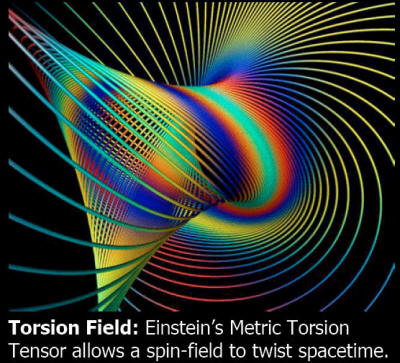
A much more elaborate description of the effects
of "torsion fields" - including some of the decades-long, remarkable Soviet
experiments which have confirmed the existence of this fundamental "new
physics" - may be found in Chapter 2 of my recent New York Times Best
Seller (with Mike Bara): "Dark
Mission: the Secret History of NASA."
This "Soviet Connection" to our own, continuing
Enterprise research in this area could also now explain part of the
recent, major Russian media interest in The Enterprise Mission.
Four Russian television networks (in addition to a number of print media)
showed up in Washington DC to cover our
recent National Press Club briefing on the
contents and political implications of our research, published in "Dark
Mission."
Afterward, the largest Russian commercial television network -
NTV -
traveled all the way from Moscow to New Mexico, to interview us about our
on-going research...

Shortly, we will post a far-ranging review of
these pioneering Soviet physics investigations into "torsion," an overview
of some of our own extraordinarily confirming observations – including
measurements made at Florida’s infamous “Coral
Castle” - and their unique relevance to the current, recurring
“NASA shuttle crisis.”
In the face of a potentially catastrophic, future Main Engine failure on a
future shuttle mission - from this "still unresolved" hydrogen sensor
problem - what has NASA got to lose by really investigating ALL options?
The real question, considering the devastating consequences of such a future
shuttle failure on the crew - on NASA and on the Nation - is simple:
"How can NASA NOT afford to seriously
investigate this very real, if 'unconventional,' research proposition?"
Based on the SCIENCE underlying the Soviet
torsion investigations and our own, parallel work, I can predict with some
confidence - along with Wayne Hale's totally separate, more "empirical"
comments, made at Saturday’s NASA shuttle briefing - that,
"Sunday’s launch attempt will encounter NO
anomalous ECO sensor readings," either before the launch... or after.
"HOW" that prediction can be made scientifically
- BEFORE the fact - will be the subject of the impending Enterprise
“torsion” publication ....
Update (12/10/07)
Obviously, much to everyone's frustration at NASA (and even among the
press...), the Space Shuttle "Atlantis" did NOT launch successfully
yesterday morning (Sunday, December 9th) - despite three days of intensive
analysis of the continuing "ECO sensor problem."
Another recurrence of the "ever-more-baffling" fuel-level sensor issue in
the shuttle's giant hydrogen tank violated the new mission rules - mandating
"four working ECO sensors at shuttle liftoff" - implemented at the specific
insistence of the crew of "Atlantis." And, the launch was scrubbed...
again...
A new attempt cannot now be made until early January, 2008.
This, of course, would appear to be in direct contradiction to our own,
specific "sensor prediction" - made hours BEFORE the launch, on Saturday,
December 8th, that, during the Sunday, December 9th second launch attempt,
"all FOUR ECO sensors will be working fine."
Thus, on the surface, our "torsion model" - on which we based this sensor
predictive analysis - would seem to have been "falsified"; some could
rightly argue (and have!), based on this "prediction failure," that
"torsion" - and our proposed "torsion's subtle effects on electrical
systems, immersed in hundreds of thousands of gallons of ultra-cold liquid
hydrogen" - is NOT responsible after all for the continuing shuttle "ECO
sensor woes"...
But... not so fast.
On Thursday, December 7th, when "Atlantis" original launch was cancelled
because of the "failing ECO sensors" at that attempt, three of the critical
sensors failed: #3 and #4, and later, #2.
This morning, as the tank was filling, two out of the three sensors that had
previously failed, "magically" worked FINE; only one of the original three -
#3 itself - failed again, a few minutes after becoming immersed in the -423
Degree F. liquid hydrogen.
This, in fact, is strong support FOR our "torsion model," underlying this
entire, mysterious "shuttle sensor problem."
As, without some actual mechanical "fix" to the shuttle sensor system in the
last three days (which NASA didn't carry out), or, some other mechanical
"intervention," NASA itself was completely baffled this morning as to how
two "previously broken electrical system" - sensors #2 and #4 - could
suddenly "heal themselves."
Our continuing bet is that the varying effects of "torsion" are directly
responsible... as we'll demonstrate in our coming, full shuttle analysis.






